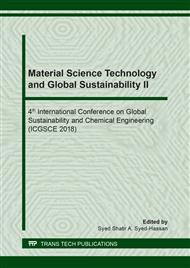[1]
D. C. Blackley, Polymer latices science and technology. Volume 2: Types of latices. London, U.K.: Chapman & Hall, (1997).
Google Scholar
[2]
Kevin, P. J. (1994). Natural rubber as a green commodity - Part II. Rubber Developments, 47, 3742.
Google Scholar
[3]
Amir Hashim, M. Y., & Rosni, M. W. (2009). Sustaining and enhancing latex products industry. Paper presented at the IRRDB Rubber Technology, Ho Chi Minh City, Vietnam.
Google Scholar
[4]
Adun, N., & Jitladda, S. (2013). A model study on effect of glucose on the basic characteristics and physical properties of natural rubber. Polymer Testing, 32, 1408-1416.
DOI: 10.1016/j.polymertesting.2013.09.003
Google Scholar
[5]
Loh, A. C. P. (1982). Further investigations of the prevulcanization of natural rubber latex. Master, The North London Polytechnic, London.
Google Scholar
[6]
Amir Hashim, M. Y., & Morris, M. D. (1999). NR latex vulcanization - Prevulcanisation and postvulcanisation of dipped NR latex films. Journal of Rubber Research, 2(2), 78-87.
Google Scholar
[7]
Jobish, J., Charoen, N., Anoma, T., & Pairote, K. (2012). Method to vulcanize natural rubber from medium ammonia latex by using glutaraldehyde. Rubber Chemistry and Technology, 85(4), 565-575.
DOI: 10.5254/rct.12.88920
Google Scholar
[8]
Abi Santhosh, A., Kuruvila, J., & Sabu, T. (2005). Recent development in crosslinking of elastomers. Rubber Chemistry and Technology, 78(3), 458-488.
Google Scholar
[9]
Guillaume, T., Bernard, B., & Bruno, A. (2011). Chemical reaction of polymer crosslinking and post-crosslinking at room and medium temperature. Progress in Polymer Science, 36, 191-217.
DOI: 10.1016/j.progpolymsci.2010.08.003
Google Scholar
[10]
Manroshan, S., & Baharin, A. (2005). Effect of nanosized calcium carbonate on the mechanical properties of latex films. Journal Applied Polymer Science, 96, 1550-1556.
DOI: 10.1002/app.21595
Google Scholar
[11]
Mohamad Akmal, A. R., Siti Nor Qamarina, M., & Amir Hashim, M. Y. (2013). The effect of grounded calcium carbonate on the physical properties of NR vulcanised latex films. Journal of Rubber Research, 16(4), 203-214.
Google Scholar
[12]
C.A. Bao , S. Kamaruddin, T.K. Yeow, K. Ing, B.T. J. Han and C. S. Ying. The Effect Of Oil Palm Fiber/Eggshell Powder Loading On The Mechanical Properties Of Natural Rubber Composites. ARPN Journal of Engineering and Applied Sciences. 11 (2016) 128 -134.
DOI: 10.1109/icmae.2016.7549508
Google Scholar
[13]
S.M. Jang, M.C. Li, J.H. Lim And U.R. Cho. Study on Properties of Natural Rubber Compound Using Starch as Filler. Asian Journal of Chemistry. 25 (2013) 5221-5225.
DOI: 10.14233/ajchem.2013.f22
Google Scholar
[14]
D. Moonchai, N. Moryadee and N. Poosodsang. Comparative Properties Of Natural Rubber Vulcanisates Filled With Defatted Rice Bran, Clay And Calcium Carbonate. Maejo International Journal of Science and Technology. 6 (2012) 249-258.
DOI: 10.1016/j.polymertesting.2013.09.013
Google Scholar
[15]
A. Samsuri. Theory and Mechanims of Filler Reinforcement in Natural Rubber. Polymer Technology, 99-120. The Royal Society of Chemistry, (2014).
Google Scholar
[16]
B.T. Sawere and A.U. Igbuku. Evaluation of Some Mechanical Properties of Composites of Natural Rubber with Egg Shell and Rice Husk. International Research Journal of Advanced Engineering and Sciences. 1 (2016) 71-75.
Google Scholar
[17]
R. Joshi, R. Singh, S.S. Gill and K.J.S. Gill. To Study the Effect of Various Additives on Vulcanied Rubber. International Conference of Advance Research and Innovation, (2015) 67-69.
Google Scholar
[18]
M. Abdollahi, A. R. (2008). Natural Rubber Latex Filler Masterbatch by Soap Sensitised Coagulant. Polymer Science, 1-10.
Google Scholar
[19]
P.A. Egwaikhide, E.E. Akporhonor and F.E. Okieimen. Effect of coconut fibre filler on the cure characteristics physico-mechanical and swelling properties of natural rubber vulcanisates. International Journal of Physics Sciences, 2 (2007) 039-046.
Google Scholar


